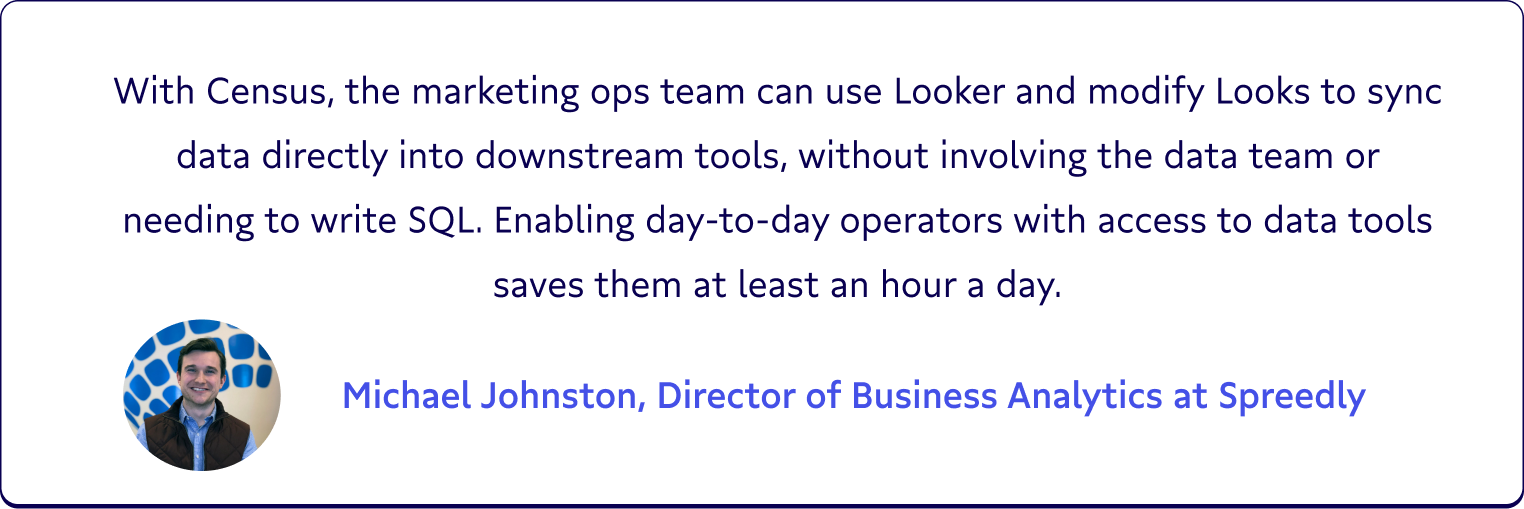👋 Hey ops folks, good news!
By using Looker Looks as models in Census, you can take business logic out of dashboards and sync directly into downstream apps to drive action.

Looker, Google Cloud’s data analytics platform, enables thousands of companies to collaborate on BI dashboards, explore their organizational data, and share insights. Analytical teams use LookML, Looker’s modeling language that generates SQL for your business users, to query and model data. With a centralized data model written in LookML, operations teams can create and edit their own reports, called Looks.
All you need to do is connect Census to an existing Looker environment. You can immediately leverage business logic built in Looker and extend those trusted models to any business tool with ease. Build once, reuse everywhere.
❤️ Customer story: Spreedly iterates faster with Looker + Census

Spreedly, a Payments Orchestration Platform, helps digital businesses build best-in-market payment systems by connecting to multiple payment services.
Michael's team uses Census to sync their data warehouse to their CRM. The Looker integration makes it easy for the marketing ops team to create and edit Looks and send modeled data directly to downstream tools – without leaving Looker or relying on data team assistance.
✨ With Census and Looker, business teams can self-serve with data in the warehouse, and power operational workflows such as:
- Hyper-personalizing sales outreach and marketing email campaigns targeted toward every stage of the customer journey, using all the data context in your warehouse
- Using Looker’s powerful visual explorer to build audiences and sync them to all your Ad destinations (Facebook, Google, LinkedIn, TikTok, etc.) from a single place
- Segmenting marketing audiences without SQL using Census Segments on top of approved Looker models, based on product usage or billing data
⚡️ Census + Looker: Operational Analytics for all
For BI or ops teams using Looker, Operational Analytics helps you achieve outcomes like:
- No more wasted effort: Before, when you created business logic in Looker, your logic wasn’t used again beyond dashboards. Now, when you expose Looks to Census as models, data from the warehouse will automatically sync everywhere.
- Inspire action, not reaction: Dashboards don’t help business users with day-to-day work like segmenting audiences or upselling customers. With Census, sync lead scores or custom audience models directly to tools like Salesforce, Braze, and Intercom.
- Better workflow efficiency: You might send scheduled deliveries from Looker. Instead of emailing Looks to ops stakeholders or exporting and importing CSVs, skip that manual work and send data directly to the ops tool.

🪄 Build once, reuse everywhere
Census helps you get more mileage out of the modeling and analysis you already do in Looker by making it simple to sync data back into business apps for action. We compile your models on the fly whenever you schedule a sync, to keep your data and models always up to date.

You can even use Looker Blocks, out-of-the-box dashboards and insights, to speed up your modeling alongside Census. For example, pair a HubSpot marketing block with sales and product data and direct that model back into HubSpot.Business teams and data teams work better together when they can iterate quickly, and trust that their data will always be reliable. Census’s syncs keep Looker and the destination app in lockstep.
🔗 How to connect your Looker environment to Census
Requirements:
- A connection to the same data source that powers Looker (for example, your data warehouse)
- API Keys from your Looker account
- Go to Models > Looker Looks > Connect Looker.
- Enter your Looker subdomain plus API Client ID and secret key.
When you connect a Looker Look, Census uses the underlying SQL from the Look as a model.
See the Census + Looker documentation for more details.
🤝 Census + Google Cloud: Better Together
Census and Google work closely together to help mutual customers accelerate action from data with reverse ETL and Operational Analytics.
In addition to Looker, Census integrates with multiple Google products that power your business. Supercharge your entire Google stack with Census:
- GCP BigQuery (source)
- Google Sheets (source)
- Google Analytics (destination)
- Google Ads (destination)
- Google Offline Conversions (destination)
- Google Sheets (destination)
- Google Cloud Storage (destination)
Check out all of our other connectors.

















